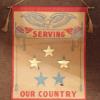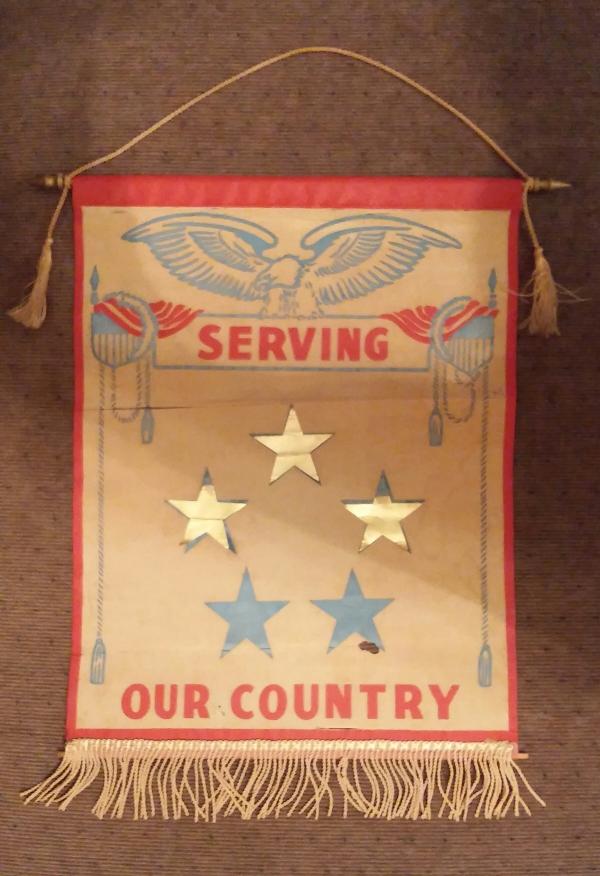American Involvement
| Grade | 9th -12th Grades | Class | U.S. History | Length of Lesson | 3-4 Days |
| Lesson Title | American Involvement |
| Unit Title | World War II |
| Unit Compelling Question | How did traditional gender roles shape the workforce during WWII? |
| Historical Context: This service flag, in the collection of the Dexter Historical Museum, hung in the window of the Mr. and Mrs. Clabe Wilson family home during and after World War II. All five of the Wilson's sons, who each grew up in Dexter, Iowa, served during World War II. The oldest two sons, Delbert and Donald, joined the Navy before the attack on Pearl Harbor in 1941. Following the attack on Pearl Harbor, Dale, Daniel and, Claiborne Wilson Jr. each joined the Army Air Corps. The five stars on the service flag each represent one of the Wilson brothers. The two blue stars represent Delbert and Donald, who returned home from the war. The gold stars represent Dale, Daniel, and Claiborne Wilson, who each lost their lives during the war. Dale R. Wilson (age 22) lost control of his B-25 bomber plane in the Pacific Theater of Operations near New Guinea. Daniel S. Wilson (age 21) and his P-38 plane were shot down in the European Theater of Operations over Austria. Claiborne D. "Junior" Wilson (age 20) and his P-40 Warhawk plane exploded during training exercises in Texas. ### While American soldiers have fought around the world in the last 75 years, WW II was the last time that Congress formally passed a declaration of war, as the U.S. Constitution intended. Other engagements have been conflicts or police actions but never sanctioned by an official declaration of war. Similarly, no other conflict since, including the Korean or Viet Nam "Wars", has so engaged both the military and civilian populations. Around 16 million Americans served directly some branch of the military. The army and navy were by far the two largest. U.S. strategy was to place primary emphasis on the defeat of Germany and its Axis allies, Austria and Italy, before dealing with the Japanese threat in the Pacific. Britain and the Soviet Union partnered with the U.S. and agreed not to make separate peace with Germany but push for total defeat. They had born the brunt of Nazi aggression for two and half bloody years before the Japanese attack on Pearl Harbor brought the U.S. in the fighting. With Italy's defeat and German surrender, a post-war Europe divided into community/Free World camps according to whose armies occupied them at the end of the conflict. American and British sea power in the Pacific eventually pushed Japan out of Asian occupied territory and gained air strips to send bombers over the Japanese Islands themselves. Finally, in August, 1945, the U.S. dropped the world's first atomic bombs forcing a Japanese surrender and opening an era of devastating potential--the Atomic Age. On the home front, American shifted to fulltime war footing. The draft began pulling young men into military service, aided by strong appeals to patriotism and criminal penalties for trying to dodge their call ups. Factories produced tanks, bombers, and jeeps instead of cars or home appliances. With major support from the Iowa State Extension Service, Iowa farmers were guaranteed top prices and produced record yields from fields and pastures. Even so, food items like meat and sugar and other transportation necessities like tires and gasoline were rationed to American families to increase supplies available for our armies and allies. With so many men taken into the military, the government made a concerted effort to recruit women into the work force, encouraging them to take jobs once considered male-only fields. The government placed price controls on many products and tried to keep wages in balance. It also made massive efforts to bolster home front morale with propaganda campaigns, movies, and bond sales. WW II was a total war effort, military and civilian, unlike any combat engagements since. Pearl Harbor galvanized public opinion into support for the war. The attacks on the World Trade Center had a similar unifying effect but the perpetrators were terrorists, not a nation state like Germany or Japan. |
|
| Lesson Supporting Question | |
| Lesson Overview | From December 7th, 1941 until the end of WWII, America was in it for the win. With the national tragedy of Pearl Harbor setting off justification for entering, the US brought out the big brother vibe to act as the overarching protectorate of the West, at least in their eyes. The point of this lesson is to explain the justifications the US used to enter the war, as well as |
| Primary Sources Used |
|
| Resources Needed | |
| Standard | |
| Lesson Target | Students will understand why American's isolationist agenda was no longer an option.;Students will understand how the war at home supported the war abroad, specifically in terms of propaganda. |
| Lesson Themes | |
|
| Formative Assessment (How will you use the formative assessments to monitor and inform instruction?) |
Classroom discussion Propaganda analysis worksheet (3)Graphic organizer on pros and cons of entering the war(1), Reflective exit slip on day 2-3 before classroom debate to spark inquiry about why humans create conflict, or more importantly, how they settle it. (2) |
| Summative Assessment (How does the lesson connect to planned summative assessment(s)?) |
Organized class debate in which the students will discuss whether or not the US made the right decision by joining the war after Pearl Harbor. This demonstrates standard SS-US.9-12.26 as they will describe the cause and effect of the situation. The students will also have to submit a written reflection about the debate and which side they are ultimately on. This is a not a paper in any sense, it is more of a demonstration of knowledge and a recap of the day’s events. |
| Author | Lauren Cockayne | Created | Last Edited | ||||
| Reviewer: Dr. Lisa Millsaps, University of Northern Iowa | |||||||
| Lesson Plan Development Notes: Lisa Millsaps | |||||||


